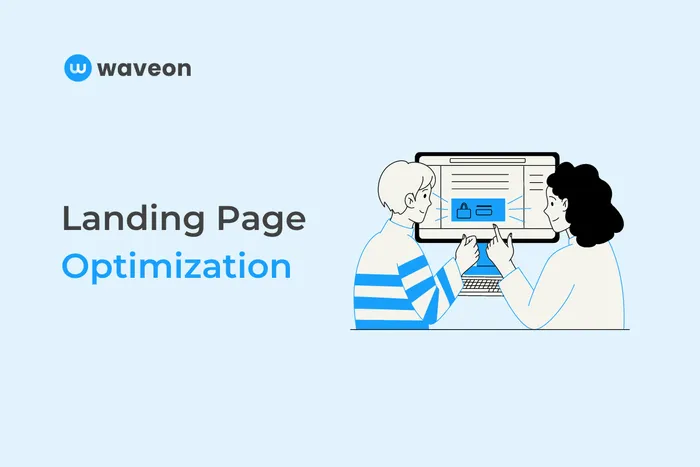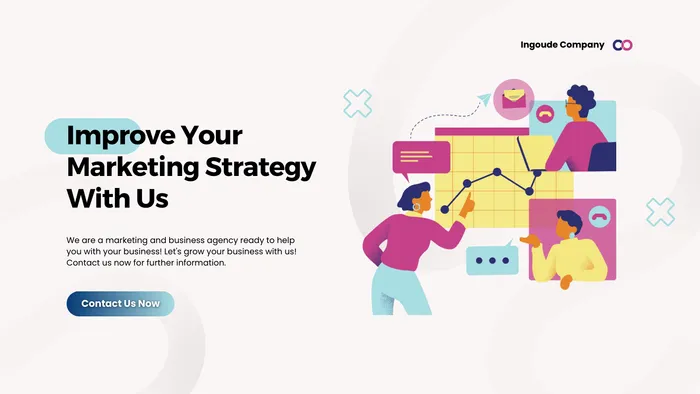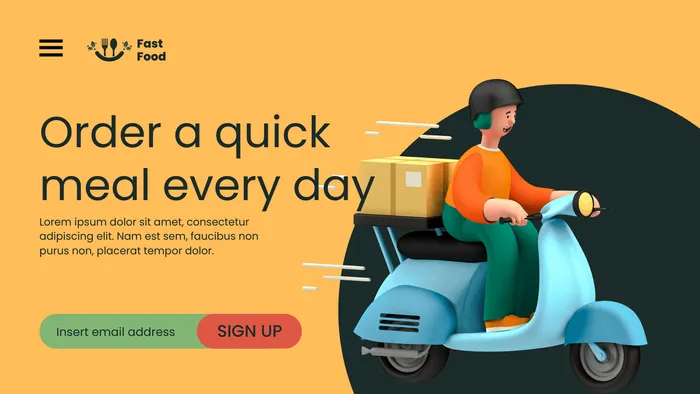Marketing
The Ultimate Guide to B2B Landing Page Optimization
Waveon Team
7/26/2023
0 min read
TABLE OF CONTENTS

You frequently visit landing pages while you navigate and surf the internet. The page you are directed to when you click on an advertisement might be called a landing page. It can also be the page that appears after a call to action button or act as a website's main page.
The goal of a landing page is to persuade you to become a lead or client, irrespective of how you "land" there. Because of this, landing pages are particularly effective parts of a business's digital marketing plan.
What is a landing page?
A landing page is a website page that has a specific aim, which is to turn viewers into customers. The goal of all landing page layouts is the same: to increase lead generation. Landing pages include lead forms that request readers' contact details in return for an offer, which is often known to be significant.
Since it is made to meet the demands of all website visitors and has too many alternatives, it is not an appropriate choice to utilize your homepage as a landing page.

Now, consider how cautious you are with your data. What might compel someone to provide their contact details online? Well, that's where best practices for landing pages come into play. Almost everyone will enter their information on a well-targeted landing page with good material and a strong style.
Most landing pages need menus and other means of navigating to different pages of your website. Instead, the visitors will be sent to a CTA that encourages them to do something, like join your mailing list, buy something, or get a quote.
When someone visits your homepage, they can click through to any of your posts without taking the proper action, or they might just be lost and hit the back button. When designing your landing page, make sure the needed course of action is crystal clear and that there are no side links or other diversions that might divert the visitor from taking the desired step.
Why do B2B companies need landing pages?
Using landing pages is a proven strategy to enhance conversion rates in digital marketing. According to a HubSpot study, companies with 30 or more landing pages generate 7 times more leads than those with fewer than 10. This highlights the effectiveness of targeted landing pages in capturing leads. By focusing on a single Call to Action (CTA) and minimizing distractions, landing pages streamline the user experience, directly guiding visitors toward conversion. The Marketing Sherpa Benchmark Report reveals that landing pages are effective for 94% of B2B companies, underscoring their universal appeal and efficacy.
Furthermore, personalized B2B landing pages are essential to successful advertising campaigns. A case study by Marketing Experiments found that a customized landing page can increase conversions by over 40%. By tailoring content to specific audience segments and aligning with the message of the advertising campaign, landing pages create a cohesive and relevant experience for the visitor. This targeted approach not only boosts conversions but also allows for precise tracking and optimization, enabling businesses to refine their strategies based on solid data and achieve better marketing ROI.
Types of Landing Pages:
A landing page can take various forms:
- Lead Generation Landing Pages: Aimed at collecting visitor information in exchange for something of value, like an e-book, a free trial, or a webinar registration.
- Click-Through Landing Pages: Often used in e-commerce, these pages lead directly to a product or offer and aim to facilitate a quick purchasing decision.
- Microsites: These are more extensive than typical landing pages and can consist of several pages, often used for specific marketing campaigns.
Tips for B2B Landing Page Optimization:
1. Maintain a basic form
Most landing pages will feature some form to gather visitor information. Even though it might be tempting to attempt to get as much data as possible on potential customers, the longer and harder a form is, the more likely it is to be discarded.
Keep your forms simple, with few fields.
The user must fill out one field if you only gather email addresses as a starting point. Evaluating several forms can help you identify the tradeoffs between gathering additional details from each lead and generating more leads if you genuinely need to collect more data.
2. Write Quality Copy
Optimizing B2B landing pages requires a strategic approach, especially when crafting compelling copy. According to a study by the Content Marketing Institute, B2B marketers who prioritize content quality over quantity see 72% more success in their marketing campaigns. This highlights the importance of engaging and persuasive copy on landing pages.
To ensure your copy resonates with a B2B audience, focus on clarity, value proposition, and problem-solving. A survey by Demand Gen Report revealed that 95% of B2B buyers prefer content that speaks directly to their company's needs. This suggests that a copy tailored to address specific industry pain points and solutions tends to be more effective in capturing B2B leads.
3. Present social proof
Presenting social proof is a crucial element in optimizing B2B landing pages. Social proof leverages the influence of others’ opinions and actions to build trust and credibility. A study by Econsultancy found that 61% of customers read online reviews before making a purchase decision, underscoring the power of social proof in influencing buying behavior. In a B2B context, showcasing client testimonials, case studies, or endorsements can significantly impact decision-making.
According to a B2B Content Marketing report by Demand Gen, 73% of B2B buyers said that case studies are the best way to build trustworthiness during the early stages of the buying process. Before individuals are willing to conduct business with you, you must gain their trust. By incorporating consumer feedback, evaluations, endorsements, and trademarks on your landing page, you can demonstrate that you deserve their confidence.
Incorporating logos of well-known clients, displaying awards or certifications, and showcasing user statistics or success rates are also effective forms of social proof. For instance, saying that “Over 1,000 businesses have successfully improved their operations using our solution,” can provide tangible evidence of your product's effectiveness.
4. Make your design simpler
It might be tempting to attempt to fit as much information as possible onto your landing page. Above all, your goal should be to persuade potential customers of the value of your service. But regarding landing pages, less nearly always makes more sense.
Use bullet points and brief paragraphs to make the most critical information simple and easy to skim. Make sure the user won't have to scroll to see your essential CTA by placing it over the page's fold. Your landing page's above-the-fold content should include a summary of the deal you're providing. Further down the page, you can elaborate on other features and information.

Additionally, you want to eliminate any pointless navigational or design features, such as menus. A landing page has only one goal: to increase conversions. You shouldn't direct visitors to other sections on your website.
5. Optimize for SEO
Optimizing your B2B landing page for search is essential to ensure it ranks well on search engines and reaches your target audience effectively. A study by Marketo revealed that organic search drives 51% of all visitors to B2B and B2C websites, highlighting the importance of search engine optimization (SEO). To optimize your landing page for search, start with keyword research. Identify relevant, high-intent keywords your target audience uses when searching for solutions like yours.
According to HubSpot, landing pages with targeted keywords can increase conversion rates by up to 300%.
Ensure your chosen keywords are strategically placed in your landing page’s title, headers, meta description, and body content. However, avoid keyword stuffing, as Google’s algorithms can penalize over-optimization. Instead, provide valuable, informative content that naturally incorporates your keywords. Content relevance is vital, with a study from the Search Engine Journal indicating that high-quality content and link building are the two most important signals used by Google to rank your website for search.
Best Practices for B2B Landing Pages:
Below, we'll go over these best practices for landing pages.
- Create a headline with a benefit at the forefront.
At least seven visitors to your landing page will leave it for every ten who arrive. Your visitors must comprehend what's in it as soon as they come to keep that number low. The significance of your landing page and offer should be communicated in your title, which they will read first.
- Pick a picture that best represents the offer.
Yes, you must have an image, and it must reflect your intended audience. Your image should show how a customer will feel after receiving your offer because its function is to elicit a sensation in the viewer. It's usually a good idea to split-test your selections because some photographs could perform better.
- Compose persuading copy.
Spend the time necessary to create the ideal headline and image; don't waste it on words that won't effectively promote your call to action. Your material must be concise and clear, directing visitors to the action you want them to take. Utilizing "you" and "your" to address the visitor directly also helps compelling text captivate them.
Use generative AI to build a preliminary draft of your landing page text, then edit it to match your brand voice and tone to expedite the writing process.
- Above the fold, include the initial form.
If a potential customer wants to convert right away, they need to be able to access your lead form easily. you want them to refrain from browsing your landing page in search of your offer. "Above the fold" implies that the form is visible when a visitor lands on the page and does not require them to scroll. This might be a link to a format or the form itself. Even better: Create your form to scroll down the page with the user.
- Incorporate a solid call to action.
The call-to-action (CTA) is one of several factors that stimulate conversion and is the most significant feature on your landing page. Use a shade different from other page components to ensure the CTA button stands out. Use an action verb that makes it obvious what you want website visitors to do, such as "OK," "download," or "find it now," to be specific regarding what you intend them to do.
- Create a responsive website.
Your landing pages must be responsive, similar to any other page on your website, to support all viewing situations. You want your form to stay on mobile devices. Give all of your visitors the chance to convert, regardless of how they are accessing your page.
- Improve search.
Your landing page will undoubtedly attract visits via email campaigns, social media postings, and other forms of promotion, but it should also be customized with relevant keywords for both paid and unpaid searches. Your landing page should appear when a user searches for your key terms. Similar to this, your landing page should contain the keywords you use to target customers with sponsored advertisements.
A well-optimized landing page is a powerful tool in your digital marketing strategy, significantly boosting conversions and ROI. However, it's important to remember that landing page optimization is not a set-it-and-forget-it task. It requires continuous testing, learning, and adapting to your audience's evolving needs and preferences. By following the strategies outlined in this guide and maintaining a data-driven approach, you can
Related topics:











